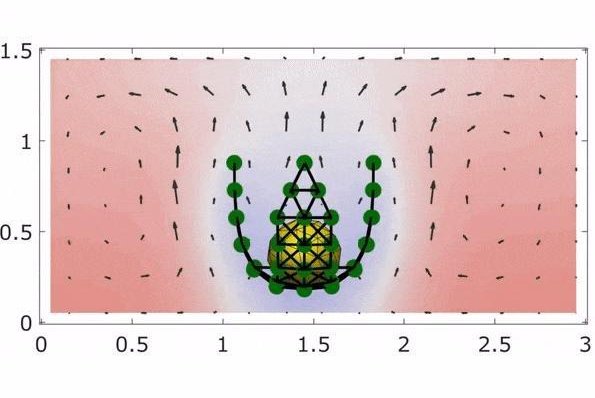The diagram shows the 2D sheet contorting to wrap itself around a ball. The sheet's autonomous movement is propelled by chemical reactions. Photo by Abhrajit Laskar
Jan. 3 (UPI) -- Scientists have developed a small shape-changing sheet that contorts in reaction to chemical catalysts. The microfluidic sheet can form 3D shapes and move autonomously in a reactant-filled fluid.
"Now we have this integrated system that utilizes a chemical reaction to activate the fluid motion that simultaneously transports a flexible object and 'sculpts' its shape, and it all happens autonomously," Anna C. Balazs, professor of chemical and petroleum engineering at the University of Pittsburgh, said in a news release.
The flexible sheet is as thin as a human hair. On its surface, scientists applied a coating of different catalysts. Reactants in the fluid react with the catalysts, causing the tiny 2D sheet to move and change shape.
"To best of our knowledge, this is the first time these catalytic chemical reactions have been applied to 2D sheets to generate flows that transform these sheets into mobile, 3D objects," Balazs said.
Scientists were able to control the succession of chemical reactions and resulting movements of the catalysts in such a way that the byproducts of early chemical reactions can influence subsequent reactions.
Different types and concentrations of catalysts and reactants can be used to produce different movements and allow the microfluidic sheet to perform different tasks.
In the lab, Pittsburgh engineers successfully programmed the sheet to wrap up an object, execute a flapping motion and tumble over surface-level obstacles.
Researchers described their successes in the journal Science Advances.
"A microfluidic device that contains these active sheets can now perform vital functions, such as shuttling cargo, grabbing a soft, delicate object, or even creeping along to clean a surface," said post-doctoral associate Oleg E. Shklyaev.
In future experiments, researchers plan to combine multiple microfluidic sheets programmed to interact and self-organize, allowing for more elaborate and complex functionality.
"Also, by experimenting with different stimuli such as heat and light, we can design mobile, 3D micro-machines that adapt their shape and action to changes in the environment," Balazs said. "This level of responsive behavior is vital to creating the next generation of soft robotic devices."















